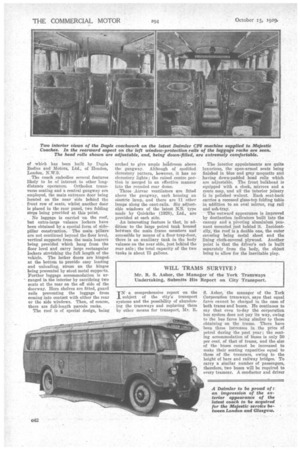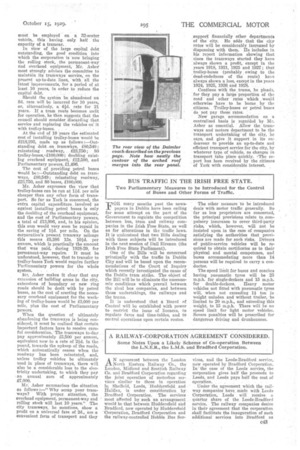WILL TRAMS SURVIVE?
Page 80

Page 81

If you've noticed an error in this article please click here to report it so we can fix it.
Mr. R. S. Asher, the Manager of the York Tramways Undertaking, Submits His Report on City Transport.
IN a comprehensive report on the subject of the city's transport systems and the possibility of abandoning the tramways and replacing them by other means for transport, Mr. IL S. Asher, the manager of the York Corporation tramways, says that equal fares cannot be charged in the case of both trams and buses. He continues to say that even to-day the corporation bus system does not pay its way, owing to the bue fares being similar to those obtaining on the trams. There have been three increases in the price of petrol during the past year; the seating accommodation of buses is only 50 per cent, of that of trams, and the size of the buses cannot be increased to make their seating capacities equal to those of the tramcars, owing to the height of bars and railway bridges. To carry a similar number of passengers, therefore, two buses will be required to every tramcar. A conductor and driver
must be employed on a 82-seater vehicle,, this having, only half the capacity of a tramcar. .
In view of the large capital debt outstanding, the good condition into which the corporation is now bringing the rolling stock, the permanent-way and Overhead equipment, Mr. Asher most strongly advises the committee to maintain its trathways service, on the present up-to-date lines, with all the latest improvements, for a period of at least 10 years; in order to reduce the capital debt. , Should the system be abandoned an 8d. rate.Will be incurred for 10 years, or, alternatively, a slid. rate for 21 years.. If a tram route becomes unfit for operation, he then suggests that the council' should consider discarding that service and replacing the vehicles on' it with trolley-buses.
At the end of 10 years the estiniated cost of installing trolley-buses would be £218,295, made up as follows :—Outstanding debt on tramways, £80,549; reinstating roadway, £23,750; 80 trolley-buses,*£100,000; doubling existing overhead equipistent, £12,590, and Parliamentary powers, £1,496.
The cost of providing petrol buses would be :—Outstanding debt on tramways, £80549; reinstating roadway, £23,750, and 80 buses,. £100,000.
Mr. Asher expresses the view that trolley-buses can be run at lid. per mile cheaper than any other form of transport. So far as York is concerned, the extra capital expenditure involved as against installing petrol buses is only the doubling of the overhead equipment, and the cost of Parliamentary powers, a total of £13,996, and, in his opinion, this sum would very soon be repaid in the saving of 14d. per mile. On the corporation's present tramway mileage this means £5,386 13s. 10141. per annum, which is practically the amount that was paid, during 1928-29, for permanent-way repairs. It must be understood, however, that to transfer to trolley-buses York would require further Parliamentary powers for the whole system. .
Mr. Asher makes it clear that any exteesion of building areas in the city, extensions of boundary or new ring roads should be dealt with by petrol buses, as the cost of erecting the necessary overhead equipment for the working of trolley-buses would be £3,000 per mile, plus the cost of Parliamentary powers.
When the question of ultimately abandoning the tramways is being considered, it must be realized that certain important factors have to receive careful consideration. The tramways to-day pay approximately 15,500 per annum, equivalent now to a rate of aid. in the pound, towards the upkeep of the roads, which automatically ceases when the roadway has been reinstated, and, unless trolley vehicles be ultimately used in place of tramways, there -will also be a considerable loss to the electricity undertaking, to which they pay .an annual sum of approximately £7,000.
Mr: Asher summarizes the situation as follows :—" Why scrap your tramways? With proper attention, the overhead equipment, permanent-way and rolling stock will last 10 years." The city tramways, he mentions, show a profit on a universal fare of 2c1., are a convenient form of transport and they support financially other departments of the' city. He adds that the city rates will be considerably increased by dispensing with them. He includes in his report information showing that since the tramways started they have always shown a profit, except in the years 1918, 1921, 1925 and 1927; that trolley-buses (probably owing to the 'dead-endedness of the route) have 'always shown a loss, except in the years 1924, 1925, 1926, and 1928. .
Continue with the . trams, he pleads, for they pay a large proportion of the road and 'other rates which would otherwise have to be borne by the citizens. Trolley-buses or petrol buses do not pay thesel rates. .
New garage accommodation on a centralized basis is regarded by Me. Asher as essential. Allow the tramways and motors department to be the transport undertaking of the city, be says, and give it support in its endeavour to provide an up-to-date and efficient transport service for the city, by whatever type of vehicle, as changes in transport take place quickly. ,The report has been received by the citizens of York with considerable interest.




























































































































